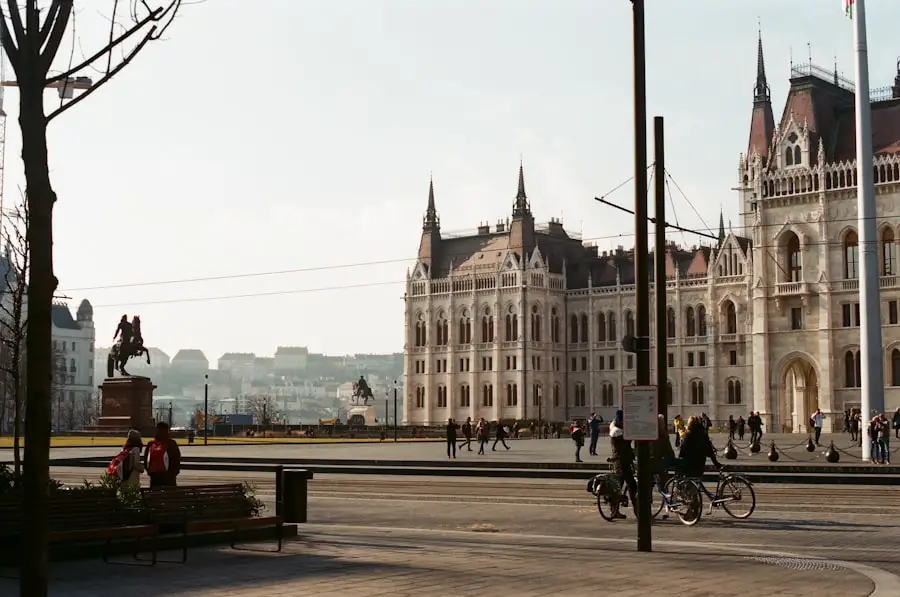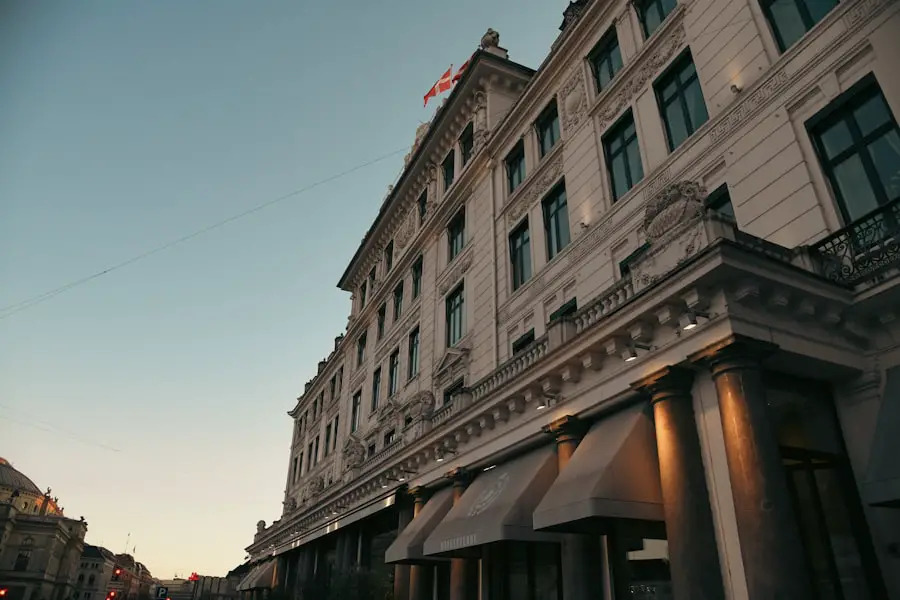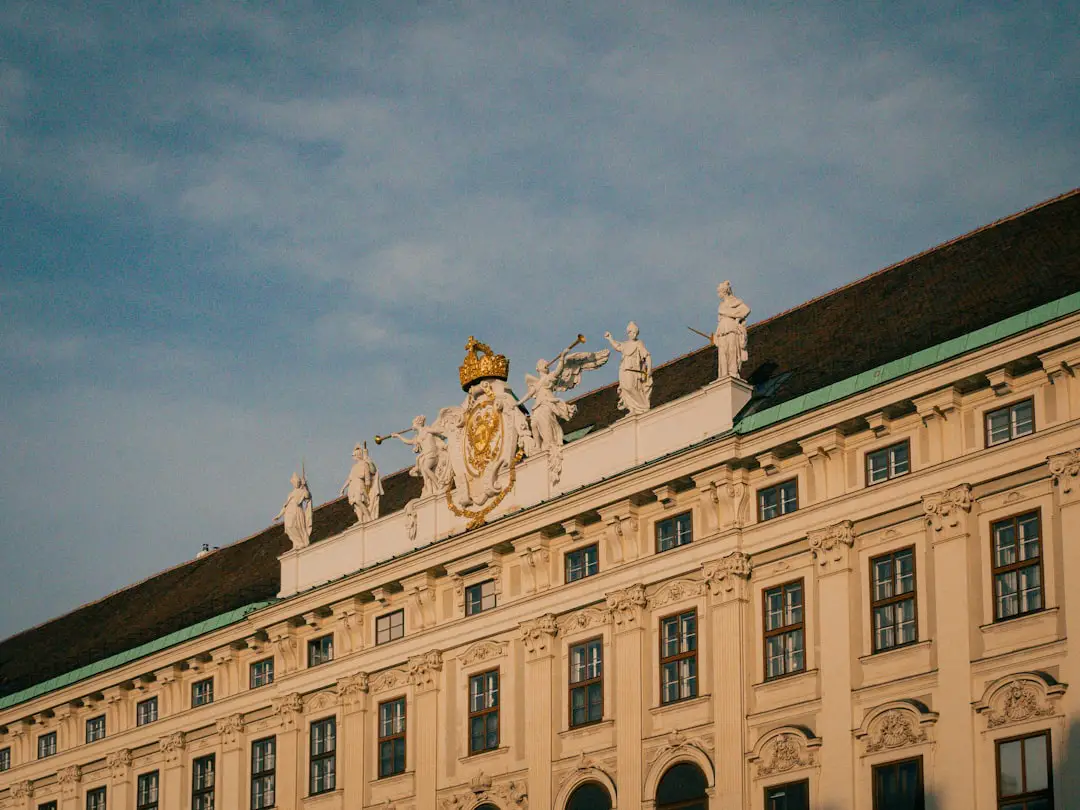Wes Anderson’s “The Grand Budapest Hotel” is a cinematic gem that has captivated audiences since its release in 2014. Set against the backdrop of a fictional European country, the film is a whimsical tale that intertwines themes of friendship, loyalty, and the passage of time. The narrative follows the adventures of Gustave H., a legendary concierge played by Ralph Fiennes, and his protégé, Zero Moustafa, as they navigate a series of misadventures involving a stolen painting and a family fortune.
The film’s unique visual style, characterized by vibrant colors and meticulously crafted sets, transports viewers to a bygone era, evoking nostalgia for a world that feels both familiar and fantastical. Anderson’s signature storytelling is evident throughout the film, as he employs a nonlinear narrative structure that adds depth to the characters and their relationships. The film’s humor is both absurd and poignant, reflecting the complexities of human nature.
With an ensemble cast that includes notable actors such as Adrien Brody, Willem Dafoe, and Tilda Swinton, “The Grand Budapest Hotel” is not just a visual feast but also a rich tapestry of performances that elevate the narrative. The film’s success at the box office and its critical acclaim, including several Academy Awards, solidify its place as one of Anderson’s most celebrated works.
Key Takeaways
- The Grand Budapest Hotel is a visually stunning film directed by Wes Anderson, known for its unique aesthetic and captivating storytelling.
- The film was inspired by the writings of Austrian author Stefan Zweig and the real-life Grandhotel Pupp in the Czech Republic.
- The Grand Budapest Hotel’s architecture is a blend of various European styles, featuring pastel colors, intricate details, and a sense of whimsy.
- Filming took place in various locations, including Germany and Poland, with meticulous attention to detail in recreating the hotel’s interior and exterior.
- The charming town of Görlitz in Germany served as a key filming location for The Grand Budapest Hotel, adding to the film’s nostalgic and timeless feel.
The Real-life Inspiration for The Grand Budapest Hotel
The inspiration for “The Grand Budapest Hotel” can be traced back to the writings of Stefan Zweig, an Austrian novelist and playwright whose works often explored themes of nostalgia and the decline of European culture in the early 20th century. Zweig’s stories frequently depicted the lives of individuals caught in the tumultuous changes of their time, mirroring the film’s exploration of loss and memory. Anderson has openly acknowledged Zweig’s influence on his storytelling, drawing parallels between the author’s experiences and the fictional world he created.
In addition to literary influences, the film also draws from Anderson’s own experiences traveling through Europe. The director has mentioned that he was inspired by various grand hotels he encountered during his journeys, particularly those that exuded a sense of history and charm. This blend of literary inspiration and personal experience culminated in a narrative that feels both timeless and specific, allowing audiences to connect with the characters on a deeper level.
The Grand Budapest itself serves as a metaphor for a lost world, one that Anderson meticulously reconstructs through his distinctive visual style.
The Stunning Architecture of The Grand Budapest Hotel

The architectural design of The Grand Budapest Hotel is one of its most striking features, serving as a character in its own right. The hotel is depicted as an opulent establishment with grand staircases, lavish lobbies, and intricate details that evoke a sense of luxury and elegance. The design draws heavily from various architectural styles, including Art Nouveau and early 20th-century European aesthetics.
This eclectic mix creates a visually stunning environment that enhances the film’s whimsical tone. The exterior of the hotel was primarily constructed using miniature models, a technique that Anderson often employs to achieve his signature look. The use of miniatures allows for precise control over every detail, from the color palette to the scale of the building itself.
This meticulous attention to detail is evident in scenes where the hotel is shown against breathtaking landscapes, further emphasizing its grandeur. The interiors were designed with equal care, featuring rich colors and ornate furnishings that transport viewers into a world of luxury and sophistication.
Behind the Scenes: Filming The Grand Budapest Hotel
| Aspect | Metric |
|---|---|
| Duration of Filming | 3 months |
| Locations | Germany |
| Number of Crew | Over 200 |
| Costume Changes | Over 1,000 |
| Props Used | Over 50,000 |
Filming “The Grand Budapest Hotel” was an intricate process that required careful planning and execution. Anderson chose to shoot primarily in Germany, utilizing various locations to bring his vision to life. One of the key filming sites was the historic Görlitz, a town known for its well-preserved architecture that perfectly matched the film’s aesthetic.
The production team transformed several locations within Görlitz into scenes from the fictional hotel, showcasing the town’s charm while creating an immersive experience for viewers. The attention to detail extended beyond just the locations; it also encompassed the costumes and props used throughout the film. Anderson collaborated with costume designer Milena Canonero to create outfits that reflected the characters’ personalities and social status.
Each costume was meticulously crafted to enhance the storytelling, with colors and styles chosen to complement the film’s vibrant palette. Additionally, props were sourced from various antique shops and flea markets to ensure authenticity in every scene.
Exploring The Grand Budapest Hotel’s Exterior Locations
The exterior locations featured in “The Grand Budapest Hotel” play a crucial role in establishing the film’s whimsical atmosphere. One notable location is the Görlitz train station, which served as a backdrop for several key scenes involving travel and adventure. The station’s vintage architecture perfectly captures the essence of early 20th-century Europe, adding authenticity to the film’s setting.
The production team utilized this location to create a sense of nostalgia while also highlighting the characters’ journeys. Another significant exterior location is the picturesque landscape surrounding Görlitz. The film features sweeping shots of snow-covered mountains and lush valleys that enhance the story’s fairy-tale quality.
These natural settings not only provide visual contrast to the hotel but also symbolize the characters’ emotional journeys throughout the film. By juxtaposing the grandeur of The Grand Budapest Hotel with the serene beauty of its surroundings, Anderson creates a rich tapestry that invites viewers into his meticulously crafted world.
The Grand Budapest Hotel’s Interior: Where Was it Filmed?

While much of “The Grand Budapest Hotel” was filmed on location in Görlitz, several interior scenes were shot on elaborate sets constructed specifically for the film. Anderson’s team built detailed replicas of various hotel rooms and common areas to ensure that every aspect of the hotel reflected his unique vision. These sets were designed with an eye for detail, incorporating elements such as ornate chandeliers, plush carpets, and vintage furnishings that evoke a sense of luxury.
One particularly memorable interior set is Gustave H.’s lavish suite, which features bold colors and intricate patterns that reflect his flamboyant personality. The design choices made for this space contribute to character development while also enhancing the overall aesthetic of the film. Each room within The Grand Budapest Hotel serves as a visual representation of its occupants’ lives, allowing viewers to glean insights into their personalities through their surroundings.
The Charming Town of Görlitz: A Key Filming Location
Görlitz, located on the border between Germany and Poland, is often referred to as one of Europe’s best-preserved towns due to its stunning architecture and rich history. This charming locale served as a primary filming location for “The Grand Budapest Hotel,” providing an authentic backdrop that perfectly complemented Anderson’s vision. With its cobblestone streets and beautifully restored buildings, Görlitz exudes an old-world charm that transports viewers back in time.
The town’s historical significance adds depth to the film’s narrative, as it reflects the cultural shifts experienced in Europe during the early 20th century. Many buildings in Görlitz date back several centuries, showcasing various architectural styles that contribute to its unique character. By choosing this location, Anderson not only captured stunning visuals but also paid homage to a region steeped in history and tradition.
The Influence of Eastern Europe on The Grand Budapest Hotel’s Aesthetic
The aesthetic of “The Grand Budapest Hotel” is heavily influenced by Eastern European culture and history. Anderson draws inspiration from various elements found in this region, including architecture, fashion, and art. The film’s fictional setting mirrors real-life Eastern European countries that experienced significant political upheaval during the early 20th century, reflecting themes of loss and nostalgia prevalent in Zweig’s works.
The color palette used throughout the film also reflects Eastern European influences, with rich reds, deep blues, and vibrant yellows creating a visually striking contrast against the snowy landscapes. This choice not only enhances the whimsical nature of the story but also evokes feelings associated with Eastern European folklore and fairy tales. By weaving these cultural elements into his narrative, Anderson creates a world that feels both fantastical and grounded in reality.
The Grand Budapest Hotel’s Connection to Wes Anderson’s Other Films
“The Grand Budapest Hotel” stands as a testament to Wes Anderson’s distinctive filmmaking style while also connecting to themes present in his previous works. Much like “Moonrise Kingdom” and “The Royal Tenenbaums,” this film explores complex family dynamics and relationships through quirky characters who navigate their own unique challenges. Anderson’s penchant for symmetry and meticulous framing is evident throughout “The Grand Budapest Hotel,” showcasing his signature visual storytelling techniques.
Moreover, recurring motifs such as nostalgia for lost eras and exploration of identity are prevalent across Anderson’s filmography. In “The Grand Budapest Hotel,” these themes are embodied through Gustave H.’s character as he grapples with change in a rapidly evolving world. This connection to previous films enriches viewers’ understanding of Anderson’s artistic vision while inviting them to explore deeper meanings within his narratives.
The Legacy of The Grand Budapest Hotel: Tourism and Pop Culture Impact
Since its release, “The Grand Budapest Hotel” has left an indelible mark on both tourism and pop culture. Görlitz has experienced an influx of visitors eager to explore the charming town featured in the film. Tourists are drawn not only by its picturesque streets but also by its connection to Anderson’s cinematic masterpiece.
Local businesses have capitalized on this interest by offering guided tours that highlight filming locations while providing insights into the production process. In addition to boosting tourism in Görlitz, “The Grand Budapest Hotel” has influenced popular culture through its distinctive visual style and memorable quotes. Fans often reference iconic lines from the film or recreate scenes for social media platforms like Instagram and TikTok.
Merchandise inspired by the film has also emerged, ranging from art prints to clothing items featuring quotes or imagery associated with The Grand Budapest Hotel.
The Grand Budapest Hotel: A Cinematic Masterpiece and Its Lasting Impact
“The Grand Budapest Hotel” is widely regarded as one of Wes Anderson’s most accomplished films, showcasing his unique ability to blend humor with poignant storytelling. Its intricate design elements, compelling characters, and rich thematic depth contribute to its status as a cinematic masterpiece. Critics have praised Anderson for his meticulous attention to detail while also highlighting how he successfully captures complex emotions within a whimsical narrative framework.
The lasting impact of “The Grand Budapest Hotel” extends beyond its initial release; it continues to resonate with audiences around the world through its exploration of nostalgia, friendship, and loss. As viewers revisit this enchanting tale time and again, they are reminded not only of its visual splendor but also of its profound emotional core—a testament to Anderson’s artistry as a filmmaker who masterfully crafts stories that linger long after the credits roll.
If you’re planning a trip to visit the filming location of The Grand Budapest Hotel, you may want to consider investing in some packing cubes to keep your belongings organized. Check out this article on 5 Must-Have Packing Cubes for Your Spring 2025 Getaway for some recommendations. These packing cubes will make it easier for you to pack and unpack during your travels, allowing you to focus on enjoying the beautiful scenery where the movie was filmed.
FAQs
Where was “The Grand Budapest Hotel” filmed?
“The Grand Budapest Hotel” was primarily filmed in Germany, with some scenes also shot in other European countries.
Which specific locations in Germany were used for filming?
The majority of the film was shot in the German cities of Görlitz and Dresden. The Grand Hotel Bellevue in the film is actually the Görlitzer Warenhaus, a department store in Görlitz.
Were any other European countries used for filming?
Yes, some scenes were also filmed in the Austrian city of Vienna.
Why were these locations chosen for filming?
Director Wes Anderson chose these locations for their architectural beauty and historical charm, which he felt captured the essence of the fictional Republic of Zubrowka depicted in the film.
Are the locations open to the public for visits?
Yes, many of the locations used for filming “The Grand Budapest Hotel” are open to the public and have become popular tourist attractions for fans of the film.
